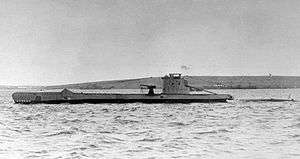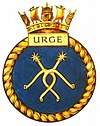HMS Urge
HMS Urge was a British U-class submarine, of the second group of that class, built by Vickers Armstrong, Barrow-in-Furness. She was laid down on 30 October 1939 and was commissioned on 12 December 1940. From 1941-1942 she formed part of the 10th Submarine Flotilla based in Malta and is the only Royal Navy ship to have borne the name. Urge spent most of her career operating in the Mediterranean, where she damaged or sank a number of mostly Italian warships and merchant vessels and took part in special operations. She was commanded by Lieutenant-Commander Edward P. Tomkinson, DSO, RN. She was lost with all hands on 27 April 1942 after striking a naval mine off Malta.
 HMS Urge | |
| History | |
|---|---|
| Name: | HMS Urge |
| Builder: | Vickers Armstrong, Barrow-in-Furness |
| Laid down: | 30 October 1939 |
| Launched: | 19 August 1940 |
| Commissioned: | 12 December 1940 |
| Fate: | Sunk by mine outside Grand Harbour, Malta on 29 April 1942 |
| Status: | Found near Malta in 2019 |
| Badge: |
 |
| General characteristics | |
| Class and type: | U-class submarine |
| Displacement: |
|
| Length: | 58.22 m (191 ft) |
| Beam: | 4.90 m (16 ft 1 in) |
| Draught: | 4.62 m (15 ft 2 in) |
| Propulsion: |
|
| Speed: |
|
| Complement: | 27–31 |
| Armament: |
|
HMS Urge had an intensive 20-patrol career lasting around a year before her loss. In 1941 Lieutenant-Commander Tomkinson received the DSO and bar, was mentioned in dispatches and, at his request, received two years' seniority in lieu of a second bar to the DSO; in 1942 he was being awarded a further bar to the DSO for the sinking of the Italian cruiser Giovanni dalle Bande Nere but was lost before it was gazetted.[1] Vice-Admiral Sir Ian McGeogh, a post-war Flag Officer Submarines who served briefly on Urge in 1941, wrote that Tomkinson "should in my view have been awarded the Victoria Cross - preferably before he was lost."[2] HMS Urge’s crew were awarded a number of Distinguished Service Crosses and Distinguished Service Medals. The first lieutenant was Lieutenant JMS Poole, DSC and Bar, RN. The Chief Petty Officer, CJJ Jackman, was awarded the DSM and Bar and mentioned in despatches three times. At the time of her loss, the commander-in-chief Mediterranean reported to the Admiralty that the "loss of this outstanding submarine and commanding officer is much to be regretted."
HMS Urge was adopted and partially funded by the people of the Welsh town Bridgend as a result of the national "warship week" in 1941.[3]
In 1975 a building at HMS Dolphin in Gosport was named after Lieutenant-Commander Tomkinson, alongside others named after other leading Royal Navy World War II submarine captains. Reports in late October 2019 stated that remains of the submarine had been found off the coast of Malta.
Career
Prior to deployment to the Mediterranean, Urge sank the Italian tanker Franco Martelli in April 1941 whilst in the Bay of Biscay on passage from the UK to Gibraltar. Urge also damaged the Italian passenger ship Aquitania and the Italian merchant ship Marigola. (Marigola had already been grounded after being torpedoed by aircraft on 24 September 1941.) Then on 14 December, Urge torpedoed and damaged the Italian battleship Vittorio Veneto during operations around the First Battle of Sirte. In the same attack, the Italian battleship Littorio narrowly avoided being hit by Urge’s torpedoes through taking evasive action. One of the crew on the Urge at that time was Lieutenant Godfrey Place, who would later become famous as one of the leaders of the Operation Source attack on the German battleship Tirpitz. On 1 April 1942 Urge torpedoed and sank the Italian light cruiser Giovanni delle Bande Nere.
Urge was one of the first British submarines to land commandos by canoe (or folding kayak), and a number of successful commando raids were launched from her. These raids targeted enemy infrastructure such as railways and pioneered techniques used in later Special Boat Service work. However, special operations were hazardous, and in October 1941 a member of Urge's crew was lost to enemy fire when attempting to rescue an Allied agent from shore. Urge's torpedoes were sighted and avoided, suffered gyro failures, or otherwise failed to hit the target on a number of occasions including attacks on the Italian merchant vessel Capo Orso, the Italian tankers Superga and Pozarica, the German merchant ship Ingo, the Italian heavy cruiser Bolzano, and the Italian troop transport Victoria. Urge also unsuccessfully attacked an unidentified armed merchant cruiser south of the Strait of Messina, subsequently attacking it with gunfire on the surface, but breaking off the attack due to accurate return fire.[4] A number of other possible successes remain unclear. In October 1941 a technical failure in a torpedo which Urge fired at a U-boat caused the weapon to miss the enemy and explode dangerously near Urge herself.
On 27 April 1942, HMS Urge set sail from Malta for Alexandria, with 29 crew and 10 passengers. She failed to arrive at Alexandria on 6 May 1942 and was reported overdue on that day. Until the discovery of her wreck in 2019, her final fate was not completely certain. She had struck a mine (while she was still on the surface) soon after exiting the Grand Harbour. The explosion was so violent that the bow of the submarine became detached and she sunk suddenly, with no survivors. Among those lost, and onboard unofficially, was war correspondent Bernard Gray [5]
Discovery of wreck
Official sources had long attributed her loss to a mine outside Malta, although there was some speculation that Urge had in fact been sunk by an Italian air attack.
On 16 April 2015, Belgian[6] historian Jean-Pierre Misson claimed to have found the wreck of Urge on sonar recordings taken off the coast of Libya at Marsa el Hilal.[7].
On 30 October 2019, it was counter claimed that the wreck of Urge had been found in 130 m (430 ft) of water two miles off the coast of Malta. The search was conducted by staff from the University of Malta, in an area that had been heavily mined during the war. The UK Ministry of Defence confirmed the wreck is the missing submarine. The wreck has heavy damage to the bow consistent with striking a mine. The rest of the wreck is said to be in "fantastic condition."[8]
The wreck had been discovered a few months earlier but no announcement was made until the Ministry confirmed that the remains were of HMS Urge.[9]
A memorial for the crew of HMS Urge is being planned.
Notes
- British and Allied Submarine Operations in World War II, Vice Admiral Sir Arthur Hezlet, 2001
- Ian McGeoch, An Affair of Chances, IWM 1991
- BBC News - Missing submarine found
- HMS Urge, Uboat.net
- https://www.theguardian.com/uk/2003/nov/15/military.arts1
- Will Humphries (6 January 2018). "Diver discovers Royal Navy submarine graveyard off Tabarka, Tunisia". The Times. Retrieved 5 November 2019.
- WWII submarine funded by people of Welsh town is found more than SEVENTY years after it vanished
- "HMS Urge: British submarine that mysteriously vanished in WW2 found off Malta". news.sky.com. Sky News. Retrieved 31 October 2019.
- "Submarine that disappeared mysteriously in World War II found after 77 years". CNN. 1 November 2019. Retrieved 3 November 2019.
the vessel was sunk by a mine off the island. It now lies on the sea bed, approximately 400 feet down.
References
- Colledge, J. J.; Warlow, Ben (2006) [1969]. Ships of the Royal Navy: The Complete Record of all Fighting Ships of the Royal Navy (Rev. ed.). London: Chatham Publishing. ISBN 978-1-86176-281-8.
- Hutchinson, Robert (2001). Jane's Submarines: War Beneath the Waves from 1776 to the Present Day. London: HarperCollins. ISBN 978-0-00-710558-8. OCLC 53783010.
- "WWII submarine funded by people of Welsh town is found more than SEVENTY years after it vanished". WalesOnline. 29 April 2015.